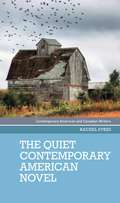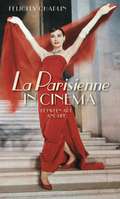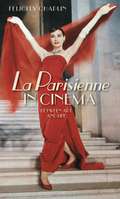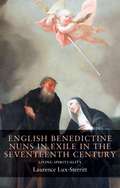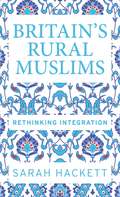- Table View
- List View
The quiet contemporary American novel
by Rachel SykesThis book explores the concept of ‘quiet’ – an aesthetic of narrative driven by reflective principles – and argues for the term’s application to the study of contemporary American fiction.
The quiet contemporary American novel (Contemporary American And Canadian Writers Ser.)
by Rachel SykesThis book explores the concept of ‘quiet’ – an aesthetic of narrative driven by reflective principles – and argues for the term’s application to the study of contemporary American fiction.
Immigrant England, 1300–1550 (Manchester Medieval Studies)
by W. Mark Ormrod Bart Lambert Jonathan MackmanThis book provides a vivid and accessible history of first-generation immigrants to England in the later Middle Ages. Accounting for upwards of two percent of the population and coming from all parts of Europe and beyond, immigrants spread out over the kingdom, settling in the countryside as well as in towns, taking work as agricultural labourers, skilled craftspeople and professionals. Often encouraged and welcomed, sometimes vilified and victimised, immigrants were always on the social and political agenda. Immigrant England is the first book to address a phenomenon and issue of vital concern to English people at the time, to their descendants living in the United Kingdom today and to all those interested in the historical dimensions of immigration policy, attitudes to ethnicity and race and concepts of Englishness and Britishness.
The road: An ethnography of (im)mobility, space, and cross-border infrastructures in the Balkans
by Dimitris DalakoglouAn ethnographic and historical study of the main Albania-Greece highway, exploring the post-Cold War political and cultural transformation of Europe through the examination of cross-border infrastructure.
The road: An ethnography of (im)mobility, space, and cross-border infrastructures in the Balkans
by Dimitris DalakoglouThis book is an ethnographic and historical study of the main Albania-Greece highway. But more than an ethnography on the road, it is an anthropology of the road. Highways are part of an explicit cultural-material nexus that includes houses, urban architecture and vehicles. Complex socio-political phenomena such as EU border security, nationalist politics, post-Cold War capitalism and financial crises all leave their mark in the concrete. This book explores anew classical anthropological and sociological categories of analysis in direct reference to infrastructure, providing unique insights into the political and cultural processes that took place across Europe after the Cold War. More specifically, it sheds light on political and economic relationships in the Balkans during the socialist post-Cold War period, focusing especially on Albania, one of the most under-researched countries in the region.
Zionism in Arab discourses (PDF)
by Uriya Shavit Ofir WinterZionism in Arab discourses presents a ground-breaking study of the Arab-Israeli conflict. Through analyses of hundreds of texts written by Arab Islamists and liberals from the late-nineteenth century to the 'Arab Spring', the book demonstrates that the Zionist enterprise has played a dual function of an enemy and a mentor. Islamists and liberals alike discovered, respectively, in Zionism and in Israeli society qualities they sought to implement in their sown homelands. Focusing on Palestinian, Egyptian, Syrian and Jordanian political discourses, this study uncovers fascinating and unexpected Arab points of views on different aspects of Zionism; from the first Zionist Congress to the First Lebanon War; from gardening in the early years of Tel Aviv to women's service in the Israeli Defence Forces; from the role of religion in the creation of the state to the role of democracy in its preservation. This study presents the debates between and within contesting Arab ideological trends on a conflict that has shaped, and is certain to continue and shape, one of the most complicated regions in the world.
La Parisienne in cinema: Between art and life
by Felicity ChaplinChic, sophisticated, seductive, and enigmatic, the Parisienne possesses a je ne sais quoi which makes her difficult to define. Who or what is the Parisienne and how she is depicted in cinema is the subject of this new and exciting book. In the first book-length publication to explore la Parisienne in cinema, Chaplin expands on existing scholarship on the Parisienne type in fields such as art history, literature, and fashion history, and builds on scholarship on the films discussed to both enrich and offer new perspectives on these films. Accessible and wide-ranging, this interdisciplinary and lively work will be of immediate interest to students and researchers working in Film Studies and French Studies and the broader humanities as well as a general interest audience. It is also essential reading for cinephiles and Francophiles alike.
La Parisienne in cinema: Between art and life
by Felicity ChaplinChic, sophisticated, seductive, and enigmatic, the Parisienne possesses a je ne sais quoi which makes her difficult to define. Who or what is the Parisienne and how she is depicted in cinema is the subject of this new and exciting book. In the first book-length publication to explore la Parisienne in cinema, Chaplin expands on existing scholarship on the Parisienne type in fields such as art history, literature, and fashion history, and builds on scholarship on the films discussed to both enrich and offer new perspectives on these films.Accessible and wide-ranging, this interdisciplinary and lively work will be of immediate interest to students and researchers working in Film Studies and French Studies and the broader humanities as well as a general interest audience. It is also essential reading for cinephiles and Francophiles alike.
English Benedictine nuns in exile in the seventeenth century: Living spirituality (Seventeenth- And Eighteenth-century Studies)
by Laurence Lux-SterrittProvides the first detailed and interdisciplinary analysis of the English Benedictine communities in exile during the seventeenth century, looking at their lived experiences, emotions and senses in religious life.
English Benedictine nuns in exile in the seventeenth century: Living spirituality (Seventeenth- And Eighteenth-century Studies)
by Laurence Lux-SterrittThis study of English Benedictine nuns is based upon a wide variety of original manuscripts, including chronicles, death notices, clerical instructions, texts of spiritual guidance, but also the nuns' own collections of notes. It highlights the tensions between the contemplative ideal and the nuns' personal experiences, illustrating the tensions between theory and practice in the ideal of being dead to the world. It shows how Benedictine convents were both cut-off and enclosed yet very much in touch with the religious and political developments at home, but also proposes a different approach to the history of nuns, with a study of emotions and the senses in the cloister, delving into the textual analysis of the nuns' personal and communal documents to explore aspect of a lived spirituality, when the body which so often hindered the spirit, at times enabled spiritual experience.
Britain’s rural Muslims: Rethinking integration (Manchester University Press)
by Sarah HackettImmigration has long been associated with the urban landscape, from accounts of inner-city racial tension and discrimination during the 1960s and 1970s and studies of minority communities of the 1980s and 1990s, to the increased focus on cities amongst contemporary scholars of migration and diaspora. Though cities have long provided the geographical frameworks within which a significant share of post-war migration has taken place, Sarah Hackett argues that that there has long existed a rural dimension to Muslim integration in Britain. This book offers the first comprehensive study of Muslim migrant integration in rural Britain across the post-1960s period, examining the previously unexplored relationship between Muslim integration and rurality by using the county of Wiltshire in the South West of England as a case study. Drawing upon a range of archival material and oral histories, it challenges the long-held assumption that local authorities in more rural areas have been inactive, and even disinterested, in devising and implementing migration, integration and diversity policies, and sheds light on smaller and more dispersed Muslim communities that have traditionally been written out of Britain’s immigration history.
Britain’s rural Muslims: Rethinking integration (Manchester University Press)
by Sarah HackettImmigration has long been associated with the urban landscape, from accounts of inner-city racial tension and discrimination during the 1960s and 1970s and studies of minority communities of the 1980s and 1990s, to the increased focus on cities amongst contemporary scholars of migration and diaspora. Though cities have long provided the geographical frameworks within which a significant share of post-war migration has taken place, Sarah Hackett argues that that there has long existed a rural dimension to Muslim integration in Britain.This book offers the first comprehensive study of Muslim migrant integration in rural Britain across the post-1960s period, examining the previously unexplored relationship between Muslim integration and rurality by using the county of Wiltshire in the South West of England as a case study. Drawing upon a range of archival material and oral histories, it challenges the long-held assumption that local authorities in more rural areas have been inactive, and even disinterested, in devising and implementing migration, integration and diversity policies, and sheds light on smaller and more dispersed Muslim communities that have traditionally been written out of Britain’s immigration history.
The power of citizens and professionals in welfare encounters: The influence of bureaucracy, market and psychology (Social And Political Power Mup Ser.)
by Nanna Mik-MeyerThis book shows the workings of power in the micro dynamics of welfare encounters. By staying close to real world welfare encounters, the book contributes to the broad scholarly field of welfare studies that either takes a Foucauldian perspective on governance, Weberian approach to the bureaucracy or contributes to the sociology of professions.
The power of citizens and professionals in welfare encounters: The influence of bureaucracy, market and psychology (Social and Political Power)
by Nanna Mik-MeyerThis book shows the workings of power in the micro dynamics of welfare encounters. By staying close to real world welfare encounters, the book contributes to the broad scholarly field of welfare studies that either takes a Foucauldian perspective on governance, Weberian approach to the bureaucracy or contributes to the sociology of professions.
Travel and the British country house: Cultures, critiques and consumption in the long eighteenth century (G - Reference, Information and Interdisciplinary Subjects)
by Jon StobartProvides readers with fresh insights into the country house and the ways it was shaped by domestic and foreign travel. It brings famous and less familiar houses to life through the aspirations and acquisitions of owners; the admiring or caustic comments of visitors, and the constant flows of goods, people and ideas.
Travel and the British country house: Cultures, critiques and consumption in the long eighteenth century
by Jon StobartProvides readers with fresh insights into the country house and the ways it was shaped by domestic and foreign travel. It brings famous and less familiar houses to life through the aspirations and acquisitions of owners; the admiring or caustic comments of visitors, and the constant flows of goods, people and ideas.
The four dimensions of power: Understanding domination, empowerment and democracy (Social and Political Power)
by Mark HaugaardIn this accessible and sophisticated exploration of the nature and workings of social and political power, Mark Haugaard examines the interrelation between domination and empowerment. Building upon the perspectives of Steven Lukes, Michel Foucault, Amy Allen, Hannah Arendt, Anthony Giddens, Pierre Bourdieu and others, Haugaard offers a clear theoretical framework, delineating power in four interrelated dimensions. The first and second dimensions of power entail two different types of social conflict. The third dimension concerns tacit knowledge, uses of truth and reification. Drawing upon genealogical theory and accounts of slavery as social death, the fourth dimension of power concerns the power to create social subjects. The book concludes with an original normative pragmatist power-based account of democracy. Offering lucid and entertaining illustrations of complex theoretical perspectives, this book is essential reading for undergraduates, postgraduates and academics, while offering an indispensable guide for activists wishing to understand domination, resistance and empowerment.
The four dimensions of power: Understanding domination, empowerment and democracy (Social and Political Power)
by Mark HaugaardThis is an original account of social/political power, which builds upon cutting edge social theory, including Steven Lukes and Michel Foucault. The book develops a four-dimensional model, in an accessible style with vivid examples. It is ideal for undergraduates, postgraduates, academics and activist who wish to understand power and conflict.
The politics of vaccination: A global history
by David CantorThis electronic version has been made available under a Creative Commons (BY-NC-ND) open access license. Mass vaccination campaigns are political projects that presume to protect individuals, communities, and societies. Like other pervasive expressions of state power - taxing, policing, conscripting - mass vaccination arouses anxiety in some people but sentiments of civic duty and shared solidarity in others. This collection of essays gives a comparative overview of vaccination at different times, in widely different places and under different types of political regime. Core themes in the chapters include immunisation as an element of state formation; citizens' articulation of seeing (or not seeing) their needs incorporated into public health practice; allegations that donors of development aid have too much influence on third-world health policies; and an ideological shift that regards vaccines more as profitable commodities than as essential tools of public health.
The politics of vaccination: A global history (Social Histories Of Medicine Ser.)
by Paul Greenough Christine Holmberg Stuart BlumeProvides a comprehensive, comparative study of global vaccine politics and their social, economic and historical context.
Gender, nation and conquest in the high Middle Ages: Nest of Deheubarth (Gender in History)
by Susan JohnsNest of Deheubarth was one of the most notorious women of the Middle Ages, mistress of Henry I and many other men, famously beautiful and strong-willed, object of one of the most notorious abduction/elopements of the period and ancestress of one of the most famous dynasties in medieval Ireland, the Fitzgeralds. This volume sheds light on women, gender, imperialism and conquest in the Middle Ages. From it emerges a picture of a woman who, though remarkable, was not exceptional, representative not of a group of victims or pawns in the dramatic transformations of the high Middle Ages but powerful and decisive actors. The book examines beauty, love, sex and marriage and the interconnecting identities of Nest as wife/concubine/mistress, both at the time and in the centuries since her death, when for Welsh writers and other commentators she has proved a powerful symbol.
Gender, nation and conquest in the high Middle Ages: Nest of Deheubarth (PDF) (Gender in History)
by Susan JohnsNest of Deheubarth was one of the most notorious women of the Middle Ages, mistress of Henry I and many other men, famously beautiful and strong-willed, object of one of the most notorious abduction/elopements of the period and ancestress of one of the most famous dynasties in medieval Ireland, the Fitzgeralds. This volume sheds light on women, gender, imperialism and conquest in the Middle Ages. From it emerges a picture of a woman who, though remarkable, was not exceptional, representative not of a group of victims or pawns in the dramatic transformations of the high Middle Ages but powerful and decisive actors. The book examines beauty, love, sex and marriage and the interconnecting identities of Nest as wife/concubine/mistress, both at the time and in the centuries since her death, when for Welsh writers and other commentators she has proved a powerful symbol.
Gothic Renaissance: A reassessment
by Elisabeth Bronfen Beate NeumeierThis collection of essays by experts in Renaissance and Gothic studies tracks the lines of connection between Gothic sensibilities and the discursive network of the Renaissance. The texts covered encompass poetry, epic narratives, ghost stories, prose dialogues, political pamphlets and Shakespeare's texts, read alongside those of other playwrights. The authors show that the Gothic sensibility addresses subversive fantasies of transgression, be this in regard to gender (troubling stable notions of masculinity and femininity), in regard to social orders (challenging hegemonic, patriarchal or sovereign power), or in regard to disciplinary discourses (dictating what is deemed licit and what illicit or deviant). They relate these issues back to the early modern period as a moment of transition, in which categories of individual, gendered, racial and national identity began to emerge, and connect the religious and the pictorial turn within early modern textual production to a reassessment of Gothic culture.
Gothic Renaissance: A reassessment (PDF)
by Elisabeth Bronfen Beate NeumeierThis collection of essays by experts in Renaissance and Gothic studies tracks the lines of connection between Gothic sensibilities and the discursive network of the Renaissance. The texts covered encompass poetry, epic narratives, ghost stories, prose dialogues, political pamphlets and Shakespeare's texts, read alongside those of other playwrights. The authors show that the Gothic sensibility addresses subversive fantasies of transgression, be this in regard to gender (troubling stable notions of masculinity and femininity), in regard to social orders (challenging hegemonic, patriarchal or sovereign power), or in regard to disciplinary discourses (dictating what is deemed licit and what illicit or deviant). They relate these issues back to the early modern period as a moment of transition, in which categories of individual, gendered, racial and national identity began to emerge, and connect the religious and the pictorial turn within early modern textual production to a reassessment of Gothic culture.
The Levellers: Radical political thought in the English Revolution (Politics, Culture and Society in Early Modern Britain)
by Rachel FoxleyThe Leveller movement of the 1640s campaigned for religious toleration and a radical remaking of politics in post-civil war England. This book, the first full-length study of the Levellers for fifty years, offers a fresh analysis of the originality and character of Leveller thought. Challenging received ideas about the Levellers as social contract theorists and Leveller thought as a mere radicalisation of parliamentarian thought, Foxley shows that the Levellers’ originality lay in their subtle and unexpected combination of different strands within parliamentarianism. The book takes full account of recent scholarship, and contributes to historical debates on the development of radical and republican politics in the civil war period, the nature of tolerationist thought, the significance of the Leveller movement and the extent of the Levellers’ influence in the ranks of the New Model Army.
